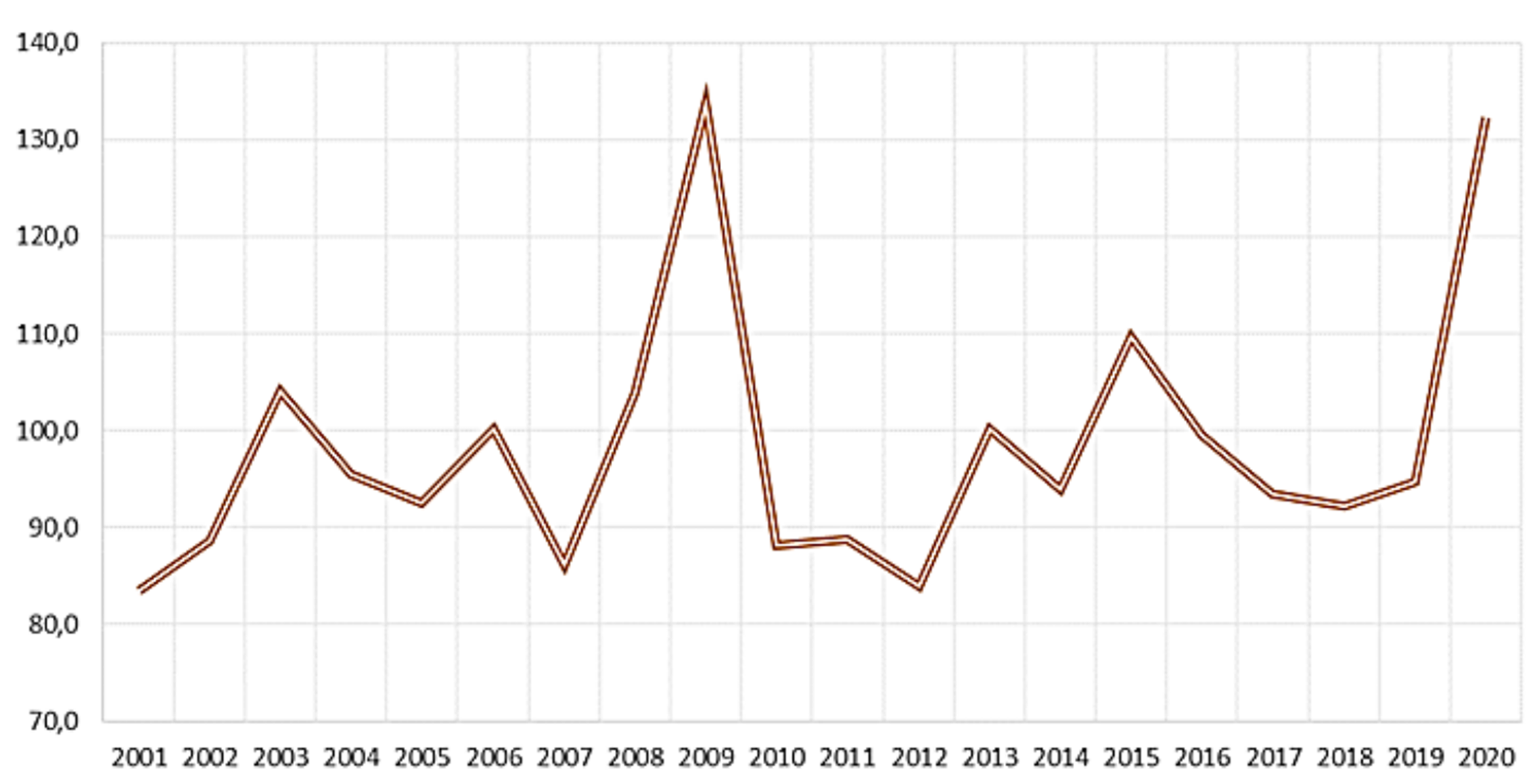Introduction
The decline in business activity during 2020 contributed to the contraction of the labor market and increased burden on the state budget. The pandemic has led to a significant increase in unemployment. The Russian labor market, unlike in previous years, reacted differently to the processes that arose as a result of Covid-19. Enterprises and organizations began to release workers much more intensively than during previous downturns in economic activity.
The formation of the Russian labor market was influenced by various relations that developed in the social and labor sphere in the pre-reform period. The most important factor that caused the decline in the socio-economic efficiency of the economy is the lack of consideration of the need to develop market institutions in those areas where the operation of public state property is less effective.
The process of paternalistic regulation of labor began almost simultaneously from the very beginning of the formation of market relations in the labor sphere, which created social mechanisms for protecting society, which are designed to protect the labor sphere as much as possible from the effectsof supply and demand mechanisms. Thus,the formation of the market took place in two directions, namely, expanding it to a huge scale for everything and limiting the impact of the market on the labor force.
Today, in Russian conditions, there are two alternative models of labor relations in practice. On the one hand, the new economic entities clearly gravitate towards the Western model of labor relations – individualized wage labor as a subject of market relations. On the other hand, traditional economic entities tend to adopt a specifically Russian model of labor relations, with its geographical and national characteristics, including state paternalism. This model of labor relations is characterized by a certain system of labor motivation, which includes not only the so-called material stimulation of labor, but also the desire of a person to take part in production management, have good working and living conditions, enjoy respect in their labor collective, have a meaningful, interesting job and the possibilityof professional communication.
It is this complex of labor motivation that is becoming very important in modern conditions. The nature of labor relations and labor values in Russia is determined by:
1. Historically established order.
2. The development of many real sector areas as state-owned or with a large share of the public sector.
3. Ideological values.
The analysis of the socio-economic development of Russia in recent years reveals certain specifics in the formation of market relations and, in particular, the labor market:
- the reduction in GDP is more significant than the reduction in employment, which dramatically reduces labor productivity;
- the problem of low wages;
- a high level of the informal sector, which significantly affects the flexibility of the Russian labor market;
– specific type of segmentation: elite, basic, marginal.
- paternalistic regulation of the labor market, which maximally protects the labor sphere from the action of supply and demand mechanisms;
- high level of hidden unemployment;
- weak development of the competition mechanism;
- reduced employment efficiency
The central problem of the Russian labor market is unemployment, which is a serious obstacle to the balanced socio-economic development of the country.
For the second time in 20 years of monitoring of unemployment, its significant growth was recorded – by a third (in 2009 – 33.8 %, in 2020-32.4 %), while in 2020 the increase in unemployment was noted against the background of a not so deep decline in GDP compared to 2009: -3.1% and -7.8%, respectively (Figure 1).

Figure 1-Dynamics of unemployment in 2001-2020 Source: compiled by the authors based on the materials of
It can be concluded that in 2020, for the first time, an accelerated increase in unemployment was recorded relative to the fall in GDP, which means the beginning of the process of releasing excess labor (hidden unemployment) at enterprises.
Restrictions imposed due to the coronavirus have led to a decline in consumer services: the volume of paid services provided to the population has decreased by more than a third. Retail trade turnover fell by 23 %. To the greatest extent, this decline is due to a collapse of more than a third in the non-food segment.
About 25 million people who work mainly in the service sector are under attack. This is more than a third of the labor force, which, according toRosstat, is 74 million people.
The impact of the pandemic has divided company employees into three groups: vital personnel who work locally, remote workers who are able to work remotely and are most likely to retain their jobs, and employees who are temporarily or permanently laid off, the bulk of which are most affected by the crisis. Currently, all of the above groups of employees are facing changes in their working methods and need additional training. Thus, field staff must take care of their physical safety, remote workers must master digital technologies and learn how to work from home, combining this with family responsibilities, and people who have lost their jobs are forced to think about retraining
As a result, the pandemic caused a sharp jump in the growth of unemployment, turning it into a serious and real problem of the country's socio-economic development. By the end of 2020, the unemployment rate was 5.9 %. Due to the introduction of quarantine measures in the spring and the temporary suspension of the work of a number of companies, this indicator rose from 4.6% to 6.4% from March to August-the highest level since 2012.
According to FinExpertiza analysts, the highest total number of unemployed FinExpertizapeople in the second quarter of 2020 was recorded in North Ossetia (39.8 % of the economically active population), Tuva (36.8%), Dagestan (36.1%), Ingushetia (30.2%). To return the Russian labor market to pre-crisis levels, it is necessary to provide jobs for another 1 million citizens. Regional programs have allocated 21 billion rubles for measures to restore employmentмлрд.
It is proposed to allocate subsidies equal to three minimum wages to employers for the employment of citizens who were registered in employment centers before January 1, 2021. It is important to note that the provision of additional subsidies and other financial assistance to businesses will not only accelerate the recovery of employment, but also stimulate business activity in the country.
As a result, the pandemic has made and continues to make significant adjustments in the functioning of the labor market, namely:
1. Tougher competition;
2. Weakening of paternalism;
3. Professional development;
4. Identification and screening of uncompetitive companies;
5. Developing ways of doing business;
6. Reduction in the number of jobs due to the introduction of new technologies;
7. Forced retraining of employees.
All this contributes to the accelerated development and optimization of the labor market. At the same time, it should be noted that any changes in the labor market and in the social sphere as a whole will be effective if the mechanism of institutional transformation is based on the peculiarities of the Russian economy and takes into account its inherent institutions.
– The Russian labor market has been able to adapt in many ways to the consequences of the COVID-19 pandemic.
- According to analysts, today the activity of Russian employers is already 3-4% higher than the pre-crisis values.
- The stabilization of the employment sector was facilitated by measures of state support for business (preferential loans for paying salaries to employees, reducing insurance premiums, tax holidays for companies from affected industries), as well as the transfer of some employees to a remote work format.
Conclusions. It can be concluded that the legalized model of remote employment will be widely used in practice, but the priority will be given to the hybrid model.
The pandemic has made serious adjustments in the Russian labor market:
- the reduction of limited resources has led to increased competition, reduced paternalism, and the release of employees.
– for the first time in many years of the labor market formation, the trend that characterized the Russian labor market – the transition of hidden unemployment to open unemployment-has been broken down in such a short period of time.
- low coverage of unemployment insurance and / or other state social support systems has led to an increase in the share of the population living "below the poverty line", deepening social inequality, which requires close attention to the problems of unemployment and adjustment of labor market policies.
Список литературы
- Starostina Yu. Experts estimate the number of unemployed Russians at the peak of the pandemic / Yu. Starostina, E. Kuznetsova / RBC. - URL: https://www.rbc.ru/economics/ 01/10/2020/5f7316249a7947dcbcb793ef (accessed on 10.02.2020).
- Timacheva E. V. Rossiiskiy rynok truda: problemy i perspektivy [Russian Labor Market: Problems and Prospects]. – 2015 – № 5 (13). – URL: https://cyberleninka.ru/ article/n/rossiyskiy-rynok-truda-problemy-i-perspektivy-1 (дата обращения: 10.02.2020)
- Utinova S. S. Isomorphic labor market in RussiaUtinova. – М., Moscow : Nauka Publ., 2003, 205 p. (in Russian)
- Federal State Statistics Service: official website. - URL: https://rosstat.gov.ru/ (accessed on 10.02.2020).
- Podkhodanova K. Reboot: how the Russian labor market was able to adapt to the pandemic / RT. - URL: https://russian.rt.com/business/article/828045-rossiya-zanyatostvakansii (accessed on 10.02.2020).



